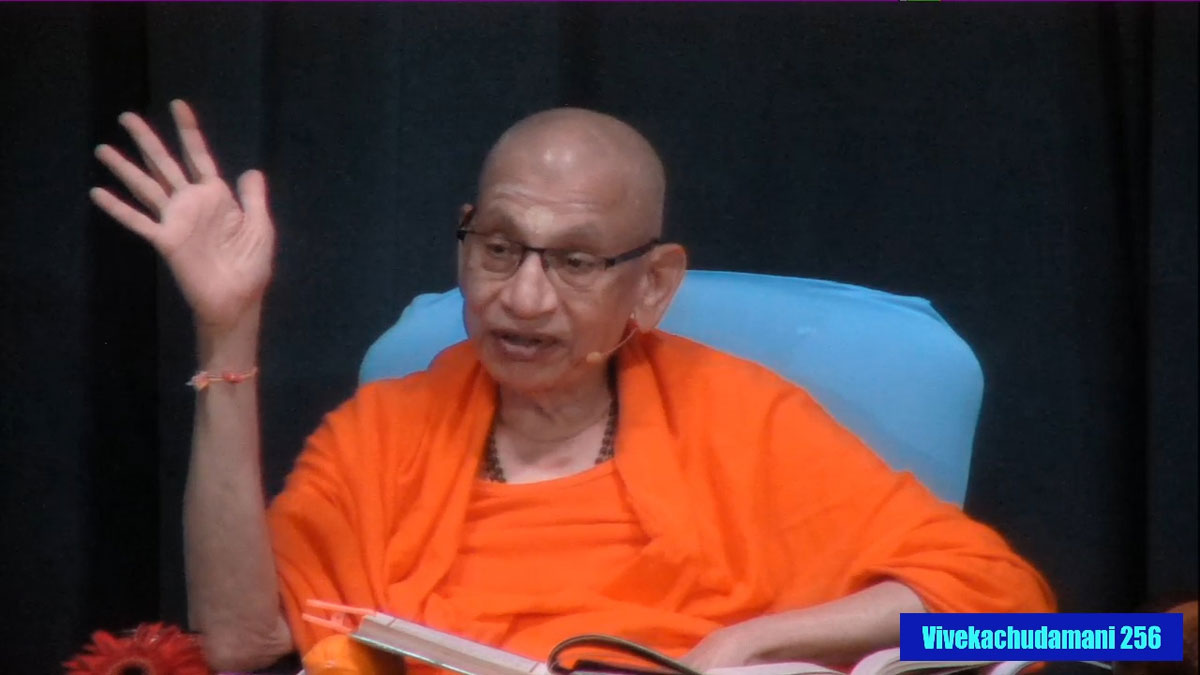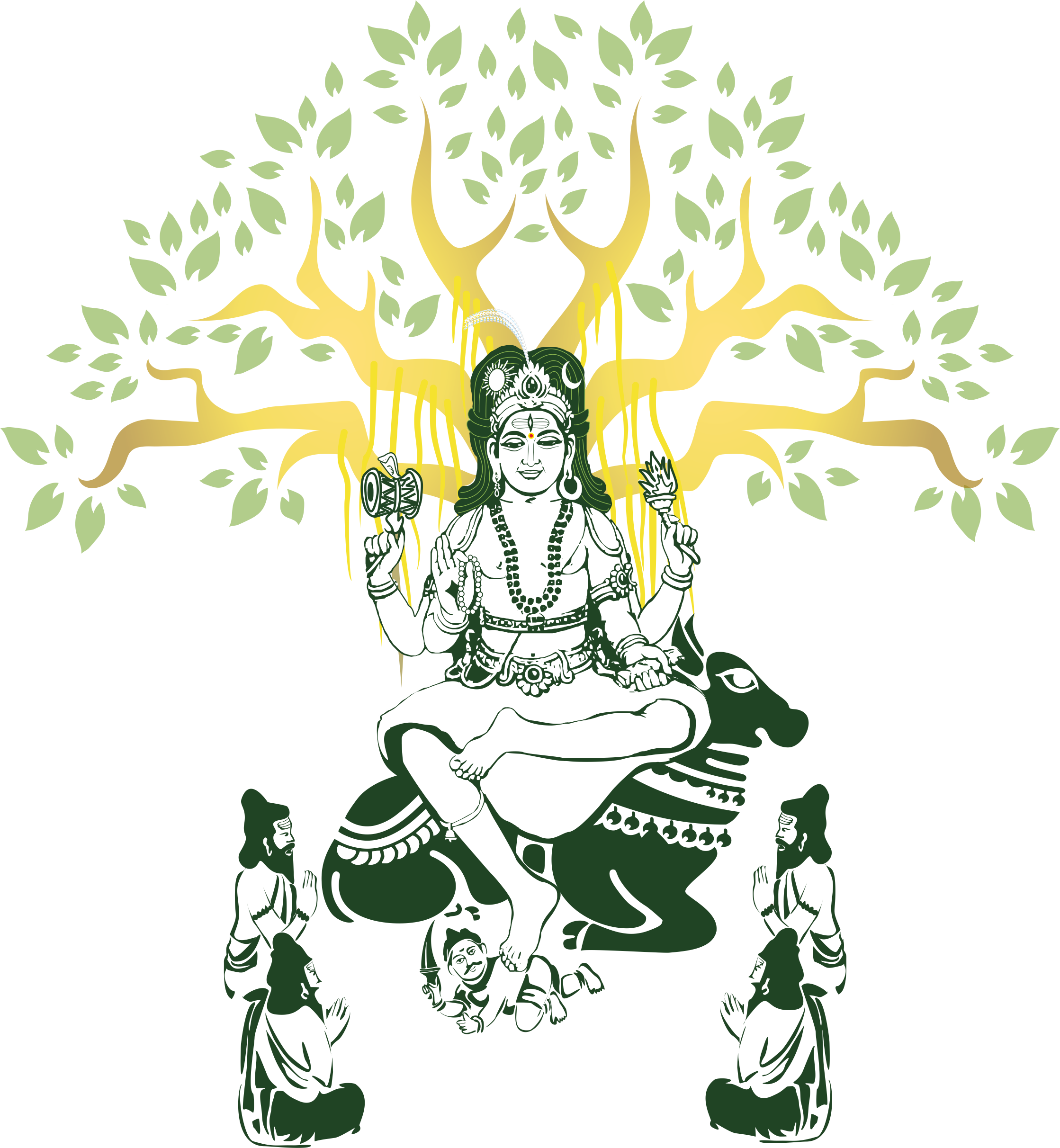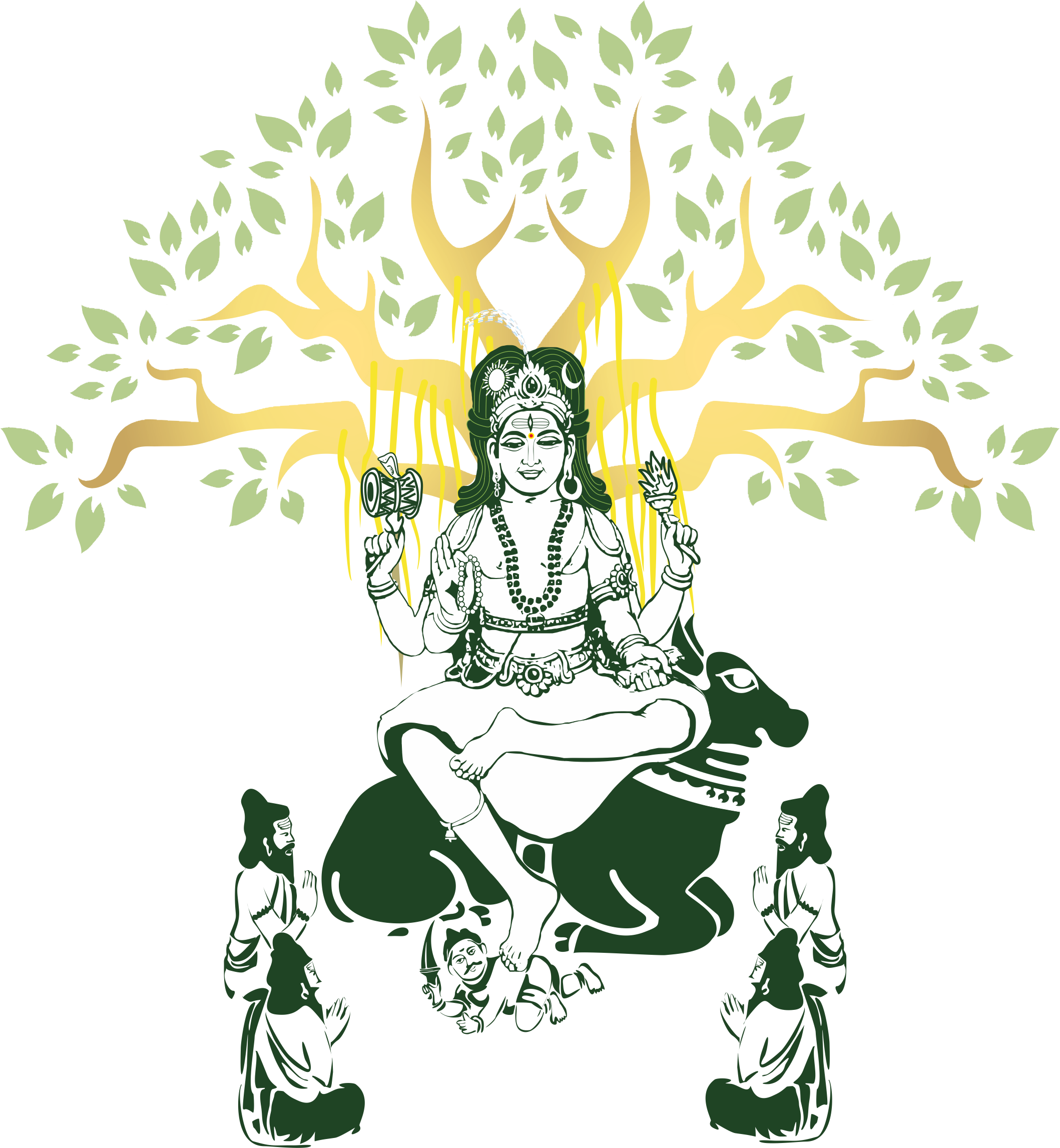Śāntipāṭha, prayer of the Gaṇapati Atharvaśīrṣa
By Swami Viditatmananda
Published in Arsha Vidya Gurukulam 33rd Anniversary Souvenir

There is a śāntipātha, or prayer, specific to each of the Vedas, chanted before the study of an Upaniṣad of that particular Veda. The prayer for the Atharva Veda, which applies to Gaṇapati Atharvaśīrṣa also, is the following:
bhadraṁ karṇebhiḥ śruṇuyāma devāḥ | bhadraṁ paśyemākṣabhiryajatrāḥ
sthirairaṅgaistuṣṭuvāgṁ sastanūbhiḥ | vyaśema devahitaṁ
yadāyuḥ
svasti na indro vṛddhaśravāḥ | svasti naḥ pūṣā viśvavedāḥ
svasti nastārkṣyo ariṣṭanemiḥ | svasti no bṛhaspatirdadhātu
om śāntiḥ śāntiḥ śāntiḥ
“Om! Oh gods (shining ones), with the ears1 may we hear what is auspicious. Oh gods (fit to be worshipped), with the eyes may we see what is auspicious. With firm limbs may we complete the full span of life allotted to us, in service to the gods, offering praise. May Indra of great fame be auspicious to us. May the all-knowing Pūṣan (Lord Sun) be auspicious to us. May Tārkṣya be auspicious to us. May Bṛhaspati bestow auspiciousness upon us.
Om Peace! Peace! Peace!”
This is a prayer for the well-being of everybody. It is traditionally chanted together by the teacher and the students, and therefore all the verbs are plural. It is a prayer to īśvara in the form of various gods. In a prayer, there is a recognition of the need for grace or blessing. We recognize that we are limited in many ways, that there are many things which are not within our control. This prayer is recited so that this study or this interaction between the teacher and the student takes place as it should, that the teacher is able to communicate what needs to be communicated, and that the student or the students understand it in the manner in which the teacher intends it. The teacher wants to convey a vision using words, and the students should get what is intended by the teacher. Sometimes the teacher may have to go beyond the derivative or commonly known meaning of the words in order to convey the vision. Therefore, in Vedānta there is a distinction between vācyārtha (literal meaning) and lakṣyārtha (implied meaning). When the vācyārtha, the literal meaning of the words, is not able to convey the teacher’s intent, there is a need to resort to lakṣyārtha, the implied meaning. What is most important is the tātparya, the intended meaning that the teacher wants to convey.2 When the commonly known eaning is not adequate, the scriptures resort to implied meaning.
Therefore, there must be a tuning between the student and
the teacher so that the student is able to appreciate what is intended by the
teacher. In case of the Upaniṣad also, since the teaching is in the form of
spoken words, tātparya-niṣcaya (ascertainment of the intended meaning) becomes
important. When communication takes place in the form of spoken words, the right
environment should prevail in terms of the proper frame of mind between the teacher
and students.
If we analyze the factors that cause disturbance in our mind,
they can be classified into three categories, based on the sources from which
they arise. First, there can be ādhyātmika, factors relating to my own self. My
body and my mind can disturb me and come in the way of my understanding.
Second, there can be ādhibhautika, factors relating to the elements in the form
of things and beings around us, including other people and animals. These can also
come in the way of the serenity of my mind. Third, there can be ādhidaivika,
factors relating to cosmic forces, such as floods, earthquakes, hurricanes, and
so on. Thus, to enjoy peace or serenity of the mind, we require a lot of grace:
grace of our own self, grace of the environment, and grace of the cosmic
forces.
Understanding the Upaniṣad is not simple, and the knowledge
it gives is also valuable, something very rare. Therefore we begin the study
with a prayer – “Oh gods, please bless us, so that we hear what is auspicious
through our ears.” In the present context, it means to please bless us so that
we are able to listen to the statements of the Upaniṣads, the nature of the
Self, the nature of brahman, the nature of Truth.
Yajatrāḥ3 is another word for devatās. Oh gods, please bless us so that we see with our eyes what is auspicious. What is auspicious? īśvara is auspicious and, as Vedānta teaches us, the whole universe is a manifestation of īśvara. Please bless us so that with our eyes we see īśvara everywhere. This is the reality, but because of my own likes and dislikes, my own ignorance, my own ego, and my own sense of I and mine, which brings about these likes and dislikes, I do not see what that reality is. Instead, I see things through the glasses of my likes and dislikes. Oh gods, please bless us so that our minds become objective and we perceive auspiciousness in whatever we see and we hear auspiciousness in whatever we hear.
Sthiraiḥ aṅgaiḥ means with healthy limbs. With firm and healthy
limbs of the body, vyaśema yad devahitaṁ āyuḥ, may we enjoy the full span of
life as allotted to us by the Lord. May our actions be performed in the spirit
of service or devotion or offering to īśvara. Tuṣṭuvāmsaḥ is from the root stu
in the sense of “to praise,” so tuṣṭuvāmsaḥ means praising, glorifying. Tanūbhiḥ
means through the Vedas, or through words. Glorifying or praising the Lord with
our words, serving the Lord with our limbs, may we spend the rest of our life
granted to us by the Lord. With the ears may we hear what is auspicious. With
eyes, may we see what is auspicious. With our limbs, hands, and legs, may we do
what is uspicious. With the speech, may we speak what is auspicious. Eyes and
ears include all the organs of perception: sound, touch, form, taste, and smell
are what we experience through the five organs of perception. Oh gods, may we
recognize the presence of īśvara through all the experiences at the level of
the sense organs. With organs of perception may we perceive īśvara and with
organs of action may we serve īśvara. May our whole life be centered around
īśvara.
When we go to a temple, we circumambulate – sometimes once,
sometimes three times, sometimes five times. The idea is that īśvara is kept in
the center of our actions and prayers at the temple. Even though we cannot
circumambulate the whole day, symbolically we can do so, keeping him in the
center.
The second part of the prayer, svasti na indro vṛddhaśravāḥ,
means may Indra of great fame be uspicious
to us. Indra is the king of all the gods, the most famous and the most powerful.
According to the Vedic scriptures, there is a presiding deity for every
function. Indra is the presiding deity of arms and therefore he is the god of
strength, with which we perform various actions. May we enjoy the blessing of
Indra. In the first part of the prayer it was said, “May we perform auspicious
actions.” Performance of auspicious actions requires the grace of Indra because
he is the presiding deity of action or karma. May Indra bless us so that
actions that we perform with our hands are auspicious, of the nature of service
to īśvara.
Svasti naḥ pūṣā viśvavedāḥ – another devatā is Pūṣan, the
nourisher, which is a name of the sun god. The sun is the nourisher of the
universe because rains are possible only because of the sun. By the heat of the
sun, water gets transformed to clouds, and from the clouds it comes down as
rain. Therefore, the sun is responsible for rain and from rain comes food, and
by food life is sustained and nourished. So among many names of Sūrya, or sun,
one is Pūṣan, the nourisher. Oh nourisher, oh sun god, may you shower
auspiciousness on us, may you be favorable. The sun is also the presiding deity
of the eyes because only when the sun illumines the objects can the eyes see
colors and forms. With the grace of the sun, may we see what is auspicious.
Svasti nastārkṣyo ariṣṭanemiḥ – Tārkṣya is a name of Garuḍa,
an eagle, the vehicle of Lord Viṣṇu, Nārāyaṇa. Ariṣṭanemi means one whose
flight cannot be obstructed. May this Tārkṣya, Garuḍa, be auspicious and
favorable to us so that there are no obstacles. This prayer is in reference to
the study of brahma-vidyā. We want the words of the teacher to carry their
meaning to us. Garuḍa, the eagle, is the vehicle of Nārāyaṇa, meaning that Lord
Nārāyaṇa comes to us riding on Garuḍa. So also, brahman comes to us riding on
the words of the teacher, one may say. Just as there are no obstructions to the
movement of Garuḍa, so also let there be no obstruction to the words of the
teacher, so that we can listen to them and understand them.
Svasti no bṛhaspatirdadhātu. Bṛhaspati is the preceptor of the
gods. He is of great intelligence and is the presiding deity of intelligence
and speech. We seek the grace of Bṛhaspati so that we are blessed with
intelligence, and also so that our speech functions properly. By the grace of Bṛhaspati,
may we be inspired with the right thoughts and words, so that we can praise the
gods and perform right actions.
This is the prayer for seeking the grace of all the
presiding deities. A few of them are mentioned here, but the idea is that with
the grace of all the gods, may the entire body-mind-sense complex be favorable
to us. We require the favor of our body, our mind, and our personality; only then
is learning and gaining this knowledge possible. If the mind does not favor us,
we have a great difficulty in applying ourselves to the study. The serenity of one’s
mind and that of the entire personality is possible only when all the presiding
deities are favorable to the person. So here we are seeking the favor of the deities,
and through them we are seeking the proper functioning of all the resources
available to us to learn. Lord Kṛṣṇa says in the Bhagavad Gītā that our mind can
be our friend or our enemy. We want the mind to be our friend; we don’t want it
to create obstacles in our path. We want the mind to always be available to us.
Om śāntih śāntiḥ śāntih. Let there be peace, peace, peace. May the peace of the mind not be disturbed by obstacles relating to the individual personality, the elemental forces, and the cosmic forces.
The prayer is for gaining a mind that is composed, that is conducive, and that is fit for study or listening to the teacher.
1 Normally by the rules of grammar, the third case plural of the word karṇa, ear, would be karṇaiḥ, but here the Veda uses karṇebhiḥ. This is chāndasa-prayoga, or Vedic usage.
2 Naiyāyikas (logicians) say that words themselves convey their meaning. The Vedāntin says that the meaning is not just contained within the words, but rather in the intent of the speaker who uses those words. A word can have more than one meaning. For example, there is a statement: saindhavam ānaya, please bring saindhava. Saindhava means that which
is born or produced in Sindhu. Sindhu again means the sea, or it also refers to the country around the river Sindhu (Indus). In the first case, saindhava would mean salt produced in the ocean. In the second case, saindhava would mean a horse bred in the territory called Sindhu. So in the sentence “saindhavam ānaya,” the context determines whether it means “Please bring salt” or “Please bring a horse.” If a person uses this sentence while eating his meal, saindhava would mean salt. If a person ready to travel a long distance utters this sentence, the word would mean a horse. From this example, it is clear that the word saindhava doesn’t determine what the meaning is; it is the one who uses the word that determines what the meaning is.
3 Yajnaiḥ trāyante iti yajatrāḥ, those who protect us by our performance of the yajña, or Vedic rituals, are called yajatrāḥ.



